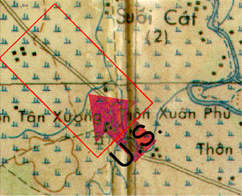 |
| Assault on Thon Tan Xuong |
Scenario
|
There were six players, one Vietcong platoon commander, one US company commander, three US platoon commanders and one ARVN platoon commander. A US rifle company (minus weapons platoon) and an ARVN rifle platoon faced a VC regular platoon reinforced with two squads of VC locals. (95 US troops, 27 ARVN vs. 50 VC). The US were supported by the company mortar section with more support on call if required. Their mission was to advance north west up the road, clearing the area of hostile forces. The Vietcong positions had been preset by me (the umpire) to save on set-up time, and the US advanced on from off table. The Vietcong player was ordered to hold up the enemy for as long as possible, but at least half his force had to remain unwounded. Full details of this scenario will be published soon. |
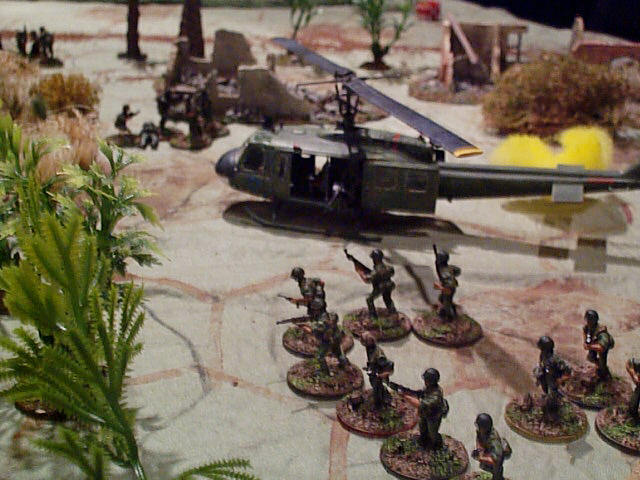 Midgame: ARVN advance in the foreground as US troops bring a casualty back for medivac |
Deployment
|
|
The US captain, Phil, initially deployed his platoons with two forward and two back in reserve. The ARVN platoon advanced through the thick scrub on the south side of the field, while a US platoon advanced up the northern side of the field across the paddy fields. |
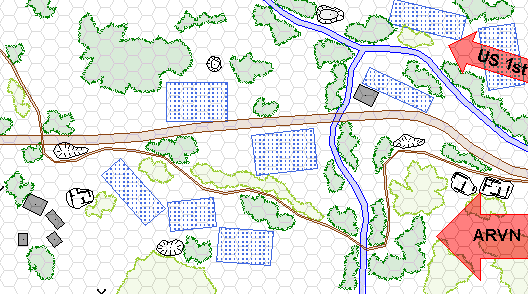
First Blood
|
|
The Vietcong struck early, with a sniper shot taking down one of the US NCOs in the first turn. Unable to spot his location, (as the sniper was firing very few shots), the platoon continued to advance. As the point squad neared a patch of jungle, a Vietcong claymore was detonated. Three troops went down immediately and two more became walking wounded. At the same time AK47s and an RPD began spraying them with bursts of automatic fire from almost point blank range. At the close of the firing all that remained of the squad were two walking wounded, although a supporting squad further back had begun to fire on the treeline in an attempt to suppress the Vietcong. The US were rapidly achieving fire superiority through prolonged machine gun bursts, and the Vietcong ambush team had taken a couple of casualties, so they decided to retreat before they became incapable of retrieving their wounded. They used successful fieldcraft rolls to extract themselves from the firing line and start working their way back through the jungle. Meanwhile the ARVN platoon were working their way through the scrub without making a single enemy contact. The squads advanced cautiously, thoroughly sweeping every patch of scrub with the platoon commander, controlled by John, directing their operations from the safe vantage point of the rear. |
Reinforcements
|
|
The northern US platoon had lost an entire squad, and had stalled while the casualties were attended to. One of the company medics was stabilising the sniper victim, while other troops worked on the claymore ambush victims. Meanwhile on the southern flank the ARVN were advancing but at a snail's pace, so the US captain decided to commit the two additional US platoons, giving them orders to advance rapidly up the centre. He also called for dust-off Hueys to extract the growing numbers of casualties. |
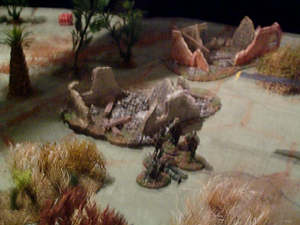 A casualty is carried back by 3rd Platoon |
Central Advance
|
|
The US 2nd Platoon commander, Steve, deployed his platoons close together in an on-line attack. As he neared the isolated hut on the east side of the river he started taking small bursts of fire from an unknown location near the river. Taking an aggressive stance the platoon continued to move forwards, firing suppressive fire at the hut area and into nearby areas of jungle. Another casualty was taken, but the US troops were soon sweeping through the hut area and into the treeline at the edge of the river. The casualties were left to lie where they fell (somewhat heartlessly and unrealistically), but were picked up by the 3rd Platoon and company HQ section as it moved up behind.The 3rd Platoon commander, Rupert, deployed them as a single mass, moving rapidly up the road through the area cleared by the 2nd Platoon. The 1st Platoon on the northern flank had started moving again, forcing its way into the jungle from which the VC ambush had been launched. The US captain had called in fire from the company mortar to attempt to cut off the VC retreat (a common tactic in Vietnam). The initial smoke round fell off table, due to a slight misreading of the map, but he soon had it adjusted correctly, and fired on several areas just west of the jungle along the river bank. Most of this fire was ineffectual, but stray shrapnel hit one of two VC running for the large page of jungle where the recoilless rifle was based. |
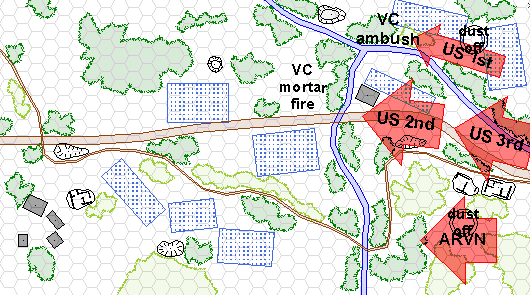
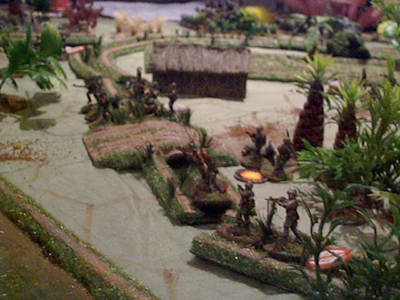 2nd Platoon scramble across the river |
Crossing the River
|
|
The second platoon now crossed the river without opposition, its alert point section spotting some anti-personnel mines on the main road bridge, which they then safely avoided. Meanwhile the second platoon HQ section at the rear had entered into a small section of jungle near the bridge and discovered a lone VC sniper, who they engaged in a fierce firefight before overrunning. The second platoon occupied the jungle on the west side of the river, and lined up along the tree line, waiting for targets. At this point VC mortar fire started to come in on their position. This was being observed through the trees by the VC platoon commander, who had a field telephone link to his single mortar. The first turn (minute) of fire fell slightly short and failed to cause casualties. In response the US captain communicated with the Bird Dog spotter which had been circling overhead to attempt to spot the position so that his mortar section could be used for counter battery fire. The second turn the fire was adjusted and caused one or two US casualties (I forget exactly). The spotter plane also managed to get an approximate fix on the mortar position, but in the following turn the VC mortar stopped firing as it only had two mortar bombs left. |
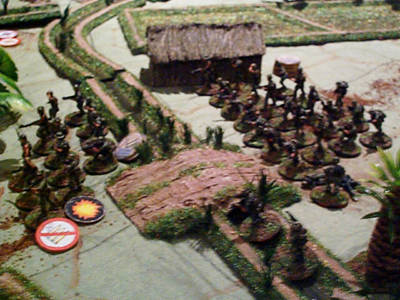 3rd Platoon follows 2nd platoon over the river |
Trapped VC
|
|
The 1st Platoon swept the entire area of jungle from which the ambush had been launched. As the neared the western tip, they encountered the VC ambush squad, which had been unable to retreat because they would have had to cross open ground which was covered by the US 2nd Platoon. All that remained were two casualties and two still combat effective. The US troops soon overran them, and cold bloodedly killed the wounded. |
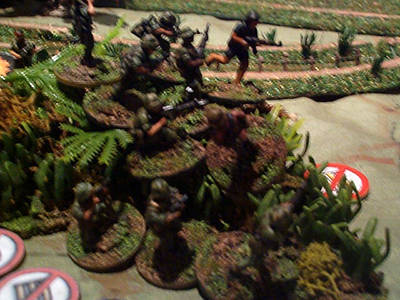 1st Platoon overruns a VC squad |
The ARVN's moment
|
|
Once the dust-off chopper had left, the ARVN advanced through the scrub towards the small foot bridge with all squads on line. There was a VC squad lying in wait, with a Claymore positioned near the bridge. Through sheer luck as the ARVN approached the bridge, their troops were positioned so that only one or two were in the area which would be affected by the mine and the VC player decided to hold his fire for a better target. The ARVN had picked up additional ammunition from the dust-off chopper and now decided to use some of it Most of the platoon lined up along the east side of the river and liberally hosed down the opposite bank with fire. Unfortunately, unknown to them the VC squad was lurking in the adjoining jungle and the section they were firing at was completely empty. At this point the game ended, because it was 2am and everyone needed to get home. |
What might have happened next
|
|
While the US assault was picking up momentum, and although the VC were making them pay for every inch, it seems likely that the US forces would have gained the field. The most important event which was looming was the VC ambush of the ARVN. The VC only had about 5 men (including a light machine gun) so although they would have been unable to hold up the ARVN for long they would have caused significant casualties. One of the US platoons would probably have had to replace the ARVN at the front of the assault, because casualties and ammo usage would have dramatically reduced the effectiveness of the platoon and brought it to a halt. |
Analysis
|
|
The ARVN player was probably the most successful, in that he secured a substantial section of the battlefield, and took no casualties at all. (The enemy bodycount was generally far less important to South Vietnamese troops - it was vital that they avoided getting their troops killed or they would be relieved of their command). The US also played a fairly solid game, although not without mistakes. Some of the platoon commanders did not sweep the area very thoroughly, in some cases allowing VC snipers to remain in position and thereby end up in the US rear area. A couple of the US platoon commanders were unfamiliar with modern infantry tactics and consequently failed to move their squad s in a co-ordinated, 'leapfrogging' fashion. The US also did not use any gunships or artillery (other than mortars), although these were available. However, as the US commander said, there was a lack of juicy targets. The Vietcong were mostly located in small pockets which were destroyed or driven back almost immediately by infantry small arms fire. The Vietcong played a very careful, cautious game, firing briefly on the US troops before hastily withdrawing. Their worst losses occurred when the squad at the northern end of the field got caught in a patch of jungle and was overrun, although with the US advancing on such a broad front, an event like this was likely to happen at some point. If this had not occurred then the game would probably have been a VC victory. The VC player suffered about 6 killed and 2 incapacitated, compared to 2 US dead, 8 incapacitated and 6 walking wounded, which was pretty much a draw. |
![]()
©2003. All rights reserved.
![]()
